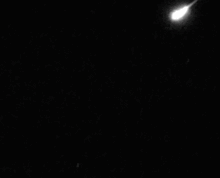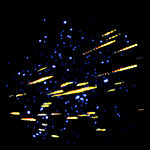十月天龙座流星雨

十月天龙座流星雨,过去曾非正式称为贾可比尼流星雨(Giacobinids,旧译为加克敏流星雨,省略号 GIA),因为它的母彗星是21P/贾可比尼-秦诺彗星 [1]。在2006年8月捷克首都布拉格的国际天文联会大会上,决定不使用彗星名字来命名流星雨[2]。这个流星雨因为辐射点在天龙座,所以称为“天龙座流星雨”(省略号 DRA)。为免混乱,国际天文联会2009年8月7日,在巴西里约热内卢的大会中,将原本在一月份出现的“天龙座流星雨”用“象限仪座流星雨”替代。问题是目前共有41个流星雨,它们的辐射点都是位于天龙座,因此再将这个十月份出现的“天龙座流星雨”更改为“十月天龙座流星雨”[3]October Draconids,但仍旧保留 DRA 这个省略号[4],以显示变化的来源。
这个流星雨出现在每年的10月初,最佳的观测日期在10月7日至9日,而最佳的观测时间则是天刚黑的数小时内,选择天空干净且黑暗无光害的场所[5]。在1933年[6][7]和1946年 [7]的天龙座流星雨曾有高达每小时数千颗流星的天顶每时出现率。罕见的爆发可能是地球穿越了彗星残骸碎片密集处造成的,例如在1998年,流星数量也曾突然飙升[8][9],在2005年也再次飙升(极引人注目)[10]。 十月天龙座流星雨的爆发[11]如预期的[12][13][14]在2011年10月8日发生,但炫目的上弦月使目视的流星数量锐减。在2012年的雷达观测,也测到每小时超过1000颗的流星。2012年的爆发,可能是母彗星在1959年遗留的狭窄灰尘和岩屑造成的[15]。
相关条目[编辑]
参考资料[编辑]
- ^ [1][永久失效链接] 译名出自《科学月刊 192期 外太空的第三类接触,作者:何丹曦‧刘康克》
- ^ Peter Jenniskens, The IAU Meteor Shower Nomenclature Rules WGN, Journal of the International Meteor Organization, Vol. 34-5, p. 127-128, 2006.
- ^ 香港天文学会智能手提电话应用程式《香港天文》2018年天象报导,余惠俊主编
- ^ IAU Meteor Data Center Meteor Number 00009
- ^ Meteor Activity Outlook for October 6-12, 2012. [2012-10-08]. (原始内容存档于2013-06-22).
- ^ John McFarland and Mark Bailey. Account of the 1933 Draconids meteor storm. International Meteor Organization (IMO). October 7, 2011 [2011-10-08]. (原始内容存档于2011-10-10).
- ^ 7.0 7.1 Kronk, Gary W. Meteor Showers Online. [2011-12-06]. (原始内容存档于2008-08-07).
- ^ Giacobinids dazzle observers. October 14, 1998 [2016-10-19]. (原始内容存档于1999-02-20).
- ^ Arlt, R. "Summary of 1998 Draconid Outburst Observations" (页面存档备份,存于互联网档案馆), WGN, Journal of the International Meteor Organization, Vol. 26, p. 256-259, 1998.
- ^ Campbell-Brown, M.; Vaubaillon, J.; Brown, P.; Weryk, R. J.; Arlt, R. "The 2005 Draconid outburst" (页面存档备份,存于互联网档案馆), Astronomy and Astrophysics, Volume 451, pp.339-344, 2006.
- ^ Draconids show expected outburst. International Meteor Organization (IMO). [2011-12-06]. (原始内容存档于2011-12-13).
- ^ Adrian West. The Draconid Meteor Shower – A Storm is Coming!. Universe Today. October 3, 2011 [2011-10-03]. (原始内容存档于2011-10-05).
Observers in the UK and Northern Europe are ideally placed to see the peak of the Draconids. Unfortunately the peak occurs in the day time for North America. There will also be a bright Moon which may drown out many but the brightest meteors, but if predictions are correct, you will still see many. You may see Draconid meteors on the 7th an the 9th also, so it is worth going out and checking the skies.
- ^ Draconids Meteor Shower on 8 October 2011. International Meteor Organization. [2016年10月19日]. (原始内容存档于2011年9月25日).
- ^ Beatty, Kelly. A Deluge of Draconids?. Sky and Telescope. Highlights. [31 December 2010]. (原始内容存档于2012-10-25).
- ^ Geert Barentsen. Draconids show outburst (again!). 2012-10-08 [2012-10-08]. (原始内容存档于2016-03-13).
- Michael D. Reynolds. Falling Stars. Stackpole Books, 2001. p. 42.
- Jun-Ichi Watanabe and Mikiya Sato. "Activities of Parent Comets and Related Meteor Showers"[永久失效链接]. Earth, Moon, and Planets, Vol 102, No 1-4 (June 2008). p111-116.
- Draconids 2011 ephemerides
外部链接[编辑]
- Draconid Meteors Over Spain (页面存档备份,存于互联网档案馆) (Astronomy Picture of the Day 2011 October 19)
- The 2012 Draconid Storm Potentially Sampled By NASA ER-2 Aircraft(页面存档备份,存于互联网档案馆) (item 12)
| ||||||||||||||||||||||||||||||||||||||||||||||||||||||||||||||||||||||||||||||||||||||||

